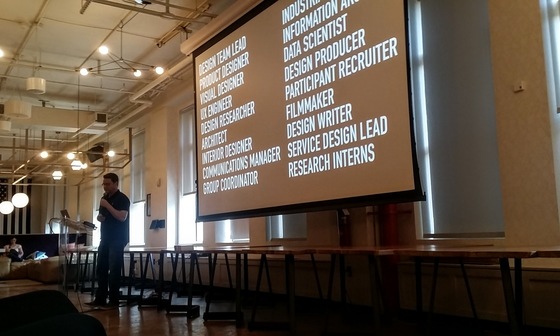WeWork brings UX thinking to co-working spaces
NEW YORK– Wework is bringing UX thinking to buildings and communities with Tomer Sharon, its VP Head of UX, talking about it last June 21 at WeWork in Chelsea through the Design Driven meetup.
Formerly with Google, Sharon recounted how he went about studying how the WeWork offices could be redesigned starting with its office on 18th Street by asking his new employer not to announce his appointment. “I pretended to be a (startup company) looking for an office,” he said.
In one portion of his presentation, he showed a time-lapse video of the people coming in and out of the building at the lobby, watching how he could make the lobby work efficiently for everyone–those entering the WeWork offices–300 at one point, not including deliveries. But we assume no one missed the big sign at the entrance, “Do what you love.” That should inspire everyone coming to its office.
Sharon didn’t stop there. He showed a photo of a smoker just outside the entrance but he didn’t offer any solution. Inside, he showed a photo of a wooden wall panel that looks like it belonged in the sixties. Perhaps you can gain some more insights in his book, — “Validating Product Ideas: Through Lean User Research.”
What is lean user research? For him, lean user research is a discipline that provides insights into users, their perspectives, and their abilities to use products and then gives this information to the right people at the right time so that the research is invaluable for developing products. Lean user research focuses on answering three big questions about people: What do people need? What do people want? Can people use the thing?
But how is lean user research different than “regular” user research? It turns out lean user research is mostly conducted by non-researchers who have burning questions about their audience (or potential audience). They want to answer these questions quickly, effectively, and on their own without hiring a professional.
However, lean user research can be at times quick and dirty, meaning some corners are cut. For example, since non-researchers might not have very good control of their body language, lean user research calls for more indirect approaches to learning. It values remote techniques over in-person ones.
Where does intuition come in, an audience asked? “We don’t always have evidence. Sometimes we take leaps of faith. But we always test,” he said.
The book is meant for product developers and managers who are not skilled researchers. Thus, research techniques are described in a relatively prescribed manner, skipping underlying factors, options, and dilemmas. The goal is to help non-skilled product developers to do their own research. “We use the language of experimentation,” he said.
If you only have time to read one chapter, he suggests Chapter 3 “How Do People Currently Solve a Problem?” It’s a guidebook, so you can choose to read any chapter in different sequences, depending on your most burning question.
Sharon also talked about the hiring process at Wework, at least for those who applied in the past. “For every role, we have asked people to write something, and asked them about their biggest design accomplishment.”
The other presenters were Mandy Cotta, head of Design at Burt’s Bees Baby & Kids, Simon Corry and Hilary Greenbaum, design director at Whitney Museum of American Art, who showed us the museum in all its new modern glory and the whimsical photos of the goings-on there, some caught napping and making use of the big program museum guide as a face mask, another even showing a blurry photo of her coming out of the subway platform.
